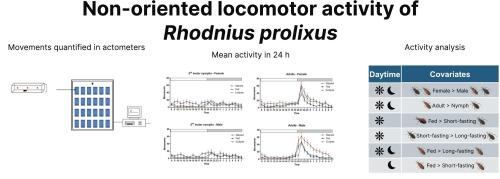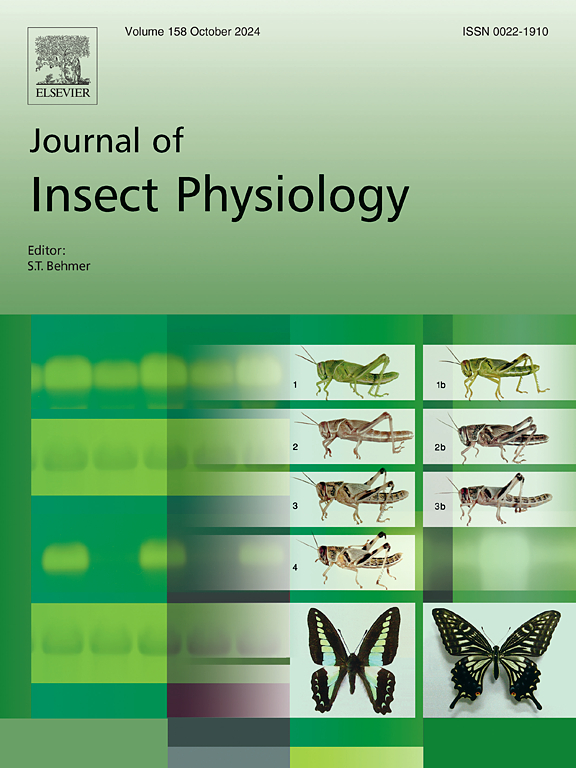Factors affecting locomotor plasticity in Rhodnius prolixus
IF 2.3
2区 农林科学
Q1 ENTOMOLOGY
引用次数: 0
Abstract
Triatomines are vectors of Trypanosoma cruzi, the causative agent of Chagas disease. Their locomotor activity is influenced by endogenous and exogenous factors, but whether individual behavioral profiles persist across developmental stages remains unclear. This study evaluated non-oriented locomotor activity in Rhodnius prolixus under varying nutritional states (short-fasting, long-fasting, fed), developmental stages (5th instar nymphs and adults), sex (males and females), and light phase (photophase vs. scotophase). In a longitudinal design using actometers, we recorded the movements of 81 insects (42 males, 39 females) over 24-hour periods at specific time points through their 5th instar and adult stage. Results revealed significant variability in activity, but statistical modeling indicated that individual differences contributed minimally to activity variation, with sex, daytime, nutritional state, and developmental stage being the primary determinants. Females were consistently more active than males and both sexes presented higher movement levels during the scotophase compared to the photophase. Adults exhibited greater activity than nymphs. While fed adults displayed higher activity levels than starved individuals, possibly linked to mating or shelter-seeking behaviors, nymphs maintained consistently low activity regardless of nutritional state, indicating a potential energy-conserving starvation-survival strategy. These findings suggest that R. prolixus locomotor activity is not an individually intrinsic trait but rather one dynamically modulated by physiological and environmental conditions, with sex- and light-phase-dependent differences shaping dispersal and survival strategies across life stages.

影响长尾蛇运动可塑性的因素。
锥虫是恰加斯病的病原体克氏锥虫的媒介。它们的运动活动受到内源性和外源性因素的影响,但个体行为特征是否在整个发育阶段持续存在尚不清楚。本研究评估了不同营养状态(短断食、长断食、喂食)、发育阶段(5龄若虫和成虫)、性别(雄性和雌性)和光照阶段(光期和暗期)下的长尾红鳉的非定向运动活动。在纵向设计中,我们记录了81只昆虫(雄42只,雌39只)在特定时间点从5龄到成虫阶段24小时内的活动情况。结果显示了活动的显著差异,但统计模型表明个体差异对活动变化的影响最小,性别、白天、营养状况和发育阶段是主要决定因素。雌性始终比雄性更活跃,在斑叶期与光期相比,两性都表现出更高的运动水平。成虫比若虫表现出更大的活动。虽然被喂食的成虫比饥饿的成虫表现出更高的活动水平,这可能与交配或寻求庇护的行为有关,但若虫无论营养状况如何,都保持着一贯的低活动,这表明一种潜在的节能饥饿生存策略。这些发现表明,长尾红的运动活动不是个体的内在特征,而是受生理和环境条件的动态调节,性别和光相依赖的差异决定了不同生命阶段的传播和生存策略。
本文章由计算机程序翻译,如有差异,请以英文原文为准。
求助全文
约1分钟内获得全文
求助全文
来源期刊

Journal of insect physiology
生物-昆虫学
CiteScore
4.50
自引率
4.50%
发文量
77
审稿时长
57 days
期刊介绍:
All aspects of insect physiology are published in this journal which will also accept papers on the physiology of other arthropods, if the referees consider the work to be of general interest. The coverage includes endocrinology (in relation to moulting, reproduction and metabolism), pheromones, neurobiology (cellular, integrative and developmental), physiological pharmacology, nutrition (food selection, digestion and absorption), homeostasis, excretion, reproduction and behaviour. Papers covering functional genomics and molecular approaches to physiological problems will also be included. Communications on structure and applied entomology can be published if the subject matter has an explicit bearing on the physiology of arthropods. Review articles and novel method papers are also welcomed.
 求助内容:
求助内容: 应助结果提醒方式:
应助结果提醒方式:


